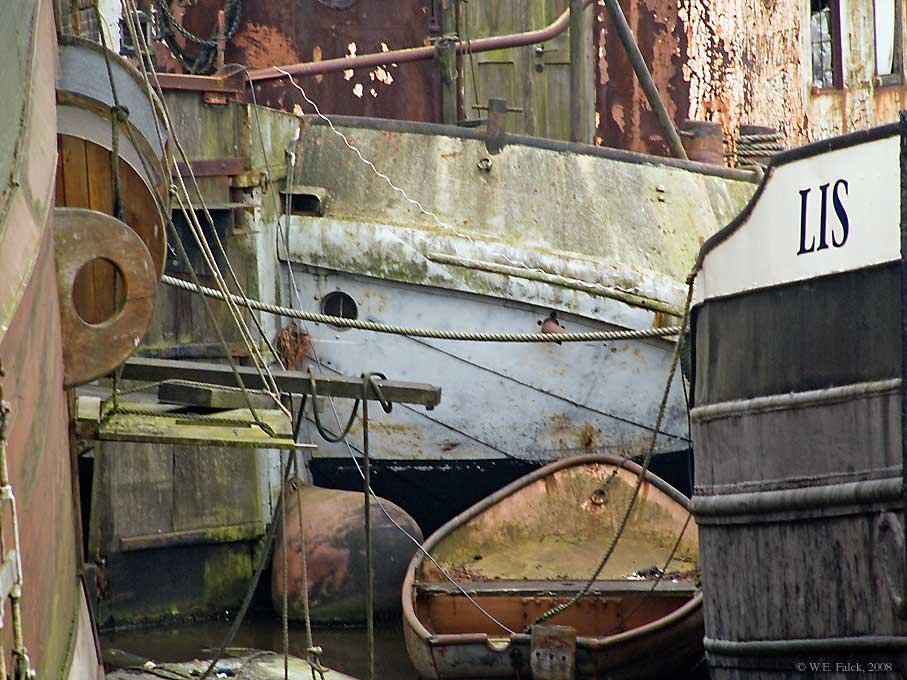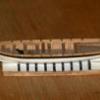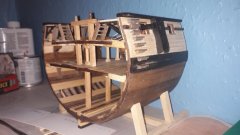MORE HANDBOOKS ARE ON THEIR WAY! We will let you know when they get here.
×
-
Posts
6,475 -
Joined
-
Last visited
Reputation Activity
-
 wefalck got a reaction from mtaylor in Stuart Engineering Lathe by Rik Thistle - FINISHED - late 1800s - 1:12 (est)
wefalck got a reaction from mtaylor in Stuart Engineering Lathe by Rik Thistle - FINISHED - late 1800s - 1:12 (est)
I happen to have an Adept No. 1 hand-shaper - but admittedly rarely use it ...
-
 wefalck got a reaction from EricWilliamMarshall in USS Tennessee 1869 by Keith Black - scale 1:120 - Wood Hull Screw Frigate - ex Madawaska 1865
wefalck got a reaction from EricWilliamMarshall in USS Tennessee 1869 by Keith Black - scale 1:120 - Wood Hull Screw Frigate - ex Madawaska 1865
Yep, those jeweller's flush cutters are very useful to nip off things flush. Had one for decades. They are meant to nip off steel watch springs, so they are very hard and tough.
I use a piece of card/paper behind the shrouds, on which the shrouds and the ratlines have been printed. This gives you a good guide to check that you didn't pull the shroud out of alignment and that the ratlines are correctly spaced.
-
 wefalck reacted to Bob Cleek in Acrylic paint tips and techniques
wefalck reacted to Bob Cleek in Acrylic paint tips and techniques
There's no shortcut. Any airbrush must be cleaned immediately after each use and it is much easier to clean if cleaned before the spraying medium hardens. This may be as simple as running some water and then cleaning solvent (e.g. Goof Off) through the brush until there is no color visible in the solvent, indicating the airbrush is completely free of paint. This can usually be accomplished in about a minute.
If your paint is properly conditioned to dry quickly, you should be able to airbrush a hull with a good amount of paint going "round and round." When you thin water-based paint with water, you must expect it will take longer to dry (cure) because water doesn't evaporate all that quickly. Thinning acrylics which can be thinned with alcohol or, if not, then with a proprietary thinner, will result in thinner paint that dries quickly because the alcohol or proprietary thinner evaporates much faster than water.
This is excellent advice. You can ask a million questions in internet forums, but the internet isn't always the best place to source information. (This forum is remarkably accurate in most instances, however.) Experience begins when you start doing it. Get an airbrush and play with it until you feel comfortable. If you run into a problem doing that, you will be able to ask a specific question instead of repeatedly asking hypothetical questions about problems you'll never encounter in real life. There are tons of airbrushing tutorial videos on YouTube. Look for those posted by the airbrush and paint manufacturers as these are the best produced and most accurate. As Nike says, "Just do it!"
See: vallejocolors - YouTube
-
 wefalck got a reaction from mtaylor in Acrylic paint tips and techniques
wefalck got a reaction from mtaylor in Acrylic paint tips and techniques
I think one has to try for oneself with one's equipment. There are so many contradictory recommendations around, that one gets easily confused and discouraged ...
-
 wefalck got a reaction from DaveBaxt in Acrylic paint tips and techniques
wefalck got a reaction from DaveBaxt in Acrylic paint tips and techniques
I think one has to try for oneself with one's equipment. There are so many contradictory recommendations around, that one gets easily confused and discouraged ...
-
 wefalck got a reaction from Canute in Stuart Engineering Lathe by Rik Thistle - FINISHED - late 1800s - 1:12 (est)
wefalck got a reaction from Canute in Stuart Engineering Lathe by Rik Thistle - FINISHED - late 1800s - 1:12 (est)
I happen to have an Adept No. 1 hand-shaper - but admittedly rarely use it ...
-
 wefalck got a reaction from thibaultron in Stuart Engineering Lathe by Rik Thistle - FINISHED - late 1800s - 1:12 (est)
wefalck got a reaction from thibaultron in Stuart Engineering Lathe by Rik Thistle - FINISHED - late 1800s - 1:12 (est)
I happen to have an Adept No. 1 hand-shaper - but admittedly rarely use it ...
-
 wefalck got a reaction from Old Collingwood in Stuart Engineering Lathe by Rik Thistle - FINISHED - late 1800s - 1:12 (est)
wefalck got a reaction from Old Collingwood in Stuart Engineering Lathe by Rik Thistle - FINISHED - late 1800s - 1:12 (est)
I happen to have an Adept No. 1 hand-shaper - but admittedly rarely use it ...
-
 wefalck got a reaction from thibaultron in Acrylic paint tips and techniques
wefalck got a reaction from thibaultron in Acrylic paint tips and techniques
I think one has to try for oneself with one's equipment. There are so many contradictory recommendations around, that one gets easily confused and discouraged ...
-
 wefalck got a reaction from Retired guy in Germania Nova 1911 by KeithAug - FINISHED - Scale 1:36 - replica of schooner Germania 1908
wefalck got a reaction from Retired guy in Germania Nova 1911 by KeithAug - FINISHED - Scale 1:36 - replica of schooner Germania 1908
Well, we all seem to suffer from more or less from the same problem: the narrative I hear from time to time goes "why don't you do something useful with your fancy tools, such as making jewellery?"
While I am quite capable of repairing things around the house (and do it, given enough urgency and inconvenience ), I prefer the creative aspect of 'making' things over 'fixing' things ...
-
 wefalck got a reaction from mbp521 in All our problems are solved: post your dodgy solutions
wefalck got a reaction from mbp521 in All our problems are solved: post your dodgy solutions
Did I mention, that I once tried to make gun-cotton? My father had a useful book, that told you everything about how to make explosives and how to test them ... perhaps I was lucky that it didn't work, because the cotton-wool I used was actually not cotton.
-
 wefalck got a reaction from GrandpaPhil in All our problems are solved: post your dodgy solutions
wefalck got a reaction from GrandpaPhil in All our problems are solved: post your dodgy solutions
Did I mention, that I once tried to make gun-cotton? My father had a useful book, that told you everything about how to make explosives and how to test them ... perhaps I was lucky that it didn't work, because the cotton-wool I used was actually not cotton.
-
 wefalck got a reaction from mtaylor in All our problems are solved: post your dodgy solutions
wefalck got a reaction from mtaylor in All our problems are solved: post your dodgy solutions
Did I mention, that I once tried to make gun-cotton? My father had a useful book, that told you everything about how to make explosives and how to test them ... perhaps I was lucky that it didn't work, because the cotton-wool I used was actually not cotton.
-
 wefalck reacted to David W in All our problems are solved: post your dodgy solutions
wefalck reacted to David W in All our problems are solved: post your dodgy solutions
As a kid we played with an AC Gilbert Chemistry Set. You could poison your sister, blow up your teacher or *gasp* play alchemist. We all had some version of this set. All we as kids did was to make gunpowder which only burned since none of us realized that it needed a confined area of some sort. Then the rich kid learned how to use other chemicals and make things go bang.
As to suit and tie - until my long term company went business casual about 1995, we were required to dress properly
-
 wefalck got a reaction from Elia in Germania Nova 1911 by KeithAug - FINISHED - Scale 1:36 - replica of schooner Germania 1908
wefalck got a reaction from Elia in Germania Nova 1911 by KeithAug - FINISHED - Scale 1:36 - replica of schooner Germania 1908
Well, we all seem to suffer from more or less from the same problem: the narrative I hear from time to time goes "why don't you do something useful with your fancy tools, such as making jewellery?"
While I am quite capable of repairing things around the house (and do it, given enough urgency and inconvenience ), I prefer the creative aspect of 'making' things over 'fixing' things ...
-
 wefalck got a reaction from mtaylor in Sloop-rigged packetboat by Strelok - 1:35 - based on Chapman plans - POB
wefalck got a reaction from mtaylor in Sloop-rigged packetboat by Strelok - 1:35 - based on Chapman plans - POB
The most primitive way would be to print the drawing on paper, cut the shape out and suspend it from several points at the edges from a thread, then draw a line in prolongation of the thread across the shape - where these lines intersect is the centre of gravity. This can be done for individual sails, whole sail plans, and longitudinal sections of the underwater-hull.
There may also free-/share-ware computer-programs that do that from various graphics inputs. Some CAD-programs have such a function.
-
 wefalck got a reaction from mtaylor in Sloop-rigged packetboat by Strelok - 1:35 - based on Chapman plans - POB
wefalck got a reaction from mtaylor in Sloop-rigged packetboat by Strelok - 1:35 - based on Chapman plans - POB
OK, I see.
Perhaps, as a reality check, you could take the loftiest (relative to hull lenght) sail-plan in those archives and compare it to your reconstruction - this should give you the enveloppe in which to develop your sail-plan. If you work with average dimensions for each part and add these together, you may arrive at an overall too lofty plan.
Another cross-check would be to graphically determine the centre of gravity of your sail-plan and compare this with that of other sail-plans. This then can also be compared to the centres of gravity of the hulls. This is what designers such as af Chapman would have done in order to see, whether hull and sail-plan balance.
-
 wefalck got a reaction from mtaylor in Sloop-rigged packetboat by Strelok - 1:35 - based on Chapman plans - POB
wefalck got a reaction from mtaylor in Sloop-rigged packetboat by Strelok - 1:35 - based on Chapman plans - POB
Are you sure, you got the proportions right? I know that some of these later 18th century vessels had very lofty spar-plans, but here the mast appears to be rather tall. The packet would have required a large amount of balast to remain stable ...
-
 wefalck got a reaction from Obormotov in MONTAÑES by Amalio
wefalck got a reaction from Obormotov in MONTAÑES by Amalio
Somehow it is a pity that all the brilliant wood-work gets buried in more and more brilliant wood-work ...
-
 wefalck got a reaction from Canute in WARNER (2022): Warships of the First Schleswig War (1848-1850)
wefalck got a reaction from Canute in WARNER (2022): Warships of the First Schleswig War (1848-1850)
WARNER, W.E. (2022): Warships of the First Schleswig War (1848-1850): The Rise of Steam Naval Combat.- 209 p. (independently published through Amazon), ca. 32€.
Since 1460 the Danish Kings ruled in personal union as dukes in Schleswig (as a fief of the Danish Crown) and Holstein (as a fief of the German Confederation). This constitutionally complicated situation was exacerbated by the fact that German and Danish populations were mixed in the north of Schleswig. The efforts of the government in Copenhagen to tie both duchies more directly to the crown in the mid-19th century led to counter-movements by the German population, which culminated in the first of three wars in 1848, the 1st Schleswig-Holstein War (known in Denmark as the ‘Three Years' War`).
Since there are only a few works on the subject and these are usually kept rather short, such a 200-page book seemed a desirable addition.
But even at first glance one can see that it was cobbled together rather hastily. There is at least one, if not several, typos on every page that should have been easy to spot when proof-reading, if not already with the spelling-checker in the word processor. A striking example is the legend on p. 13, in which Flensburg appears in Danish spelling once as Frensborg, twice as Flenborg and once each as Flesborg and Felsborg, sometimes in the same sentence ... In addition, there are incomplete and incoherent sentences on practically every page. Some paragraphs and whole chapters look like automatic translations from Danish or German. For significant stretches the text actually reads like German or Danish with English words.
Speaking of 'Flensborg': it is not entirely understandable why the Danish spelling of the place names was predominantly used, even for Holstein areas, where this may have only appeared in official documents in Copenhagen. A Danish-German-English comparison table on page 202 indicates that for place names in the text predominantly the German version was used, which is de facto incorrect.
It is also frustrating that the text and action maps do not always match, i.e. the text mentions places that are not marked on the maps, so you have to constantly consult an atlas to understand the text.
Such a lack of formal care usually undermines any confidence in the reliability of content. The historical overview then indeed suggests that the author only deals very cursorily with the complex history of Schleswig-Holstein and has not developed a deeper understanding of the mixture of conflicting interests. However, I did not check the factual accuracy of the historical outline against the literature available to me. As a curiosity, Appendix 4 could be mentioned, in which the Danish Espignol is described, but a quick Internet search reveals that the author did not bother to really understand the function and arrangement of this volley gun.
The title of the book suggests that it is about the warships used in this conflict and we are lucky that the Danish archives are quite rich on virtually every ship named in it, including various of those used by the German forces, as they were either of Danish origin or ended up in Danish hands. I would have expected to see this source material mentioned and perhaps referenced for easy look-up. Instead, the ships are only illustrated by way of drawings that presumably are based on an interpretation of this archival material and reproductions of some historical works of art that were often made decades after the event. Similarly, the armament of the ships used is discussed only briefly, with the exception of the espignols mentioned above, which also appear to have been used abord of Danish ships.
Interesting is an appendix that discusses the housing in Copenhagen of PoWs and civilian detainees, including the seamen from German merchant ships taken as prizes or seized in harbours. Hulks of old navy ships were used for the purpose, as in the days of e.g. the Napoleonic Wars.
The list of references in such works is always interesting to peruse, as it shows how thoroughly the author has consulted the contemporary and secondary literature. It is quite striking that little German literature was used. For example, there is a sub-heading for ‘official Danish sources’, but noting corresponding for German sources (which admittedly are more scanty due to war losses).
One can easily see from that that the book was obviously hastily pieced together from various contributions in a Facebook forum (mentioned in the foreword) without having undergone a thorough editorial processing (NB, the author put proudly his PhD onto the front cover, but if it were his thesis, the supervisor would have turned it back to him after reading a couple of pages …).
The final question: “Is it worth buying the book?” can be answered with a pretty clear ‘no’. The book has a lot of potential, but would need to be revised very thoroughly in terms of content and form.
-
 wefalck got a reaction from Dave_E in What options for brass fittings?
wefalck got a reaction from Dave_E in What options for brass fittings?
The appearance of blackened vs. painted surfaces is different, it depends on what you are trying to achieve/simulate.
Personally, if parts are not to be handled significantly afterwards, I just clean with acetone and then spray-paint with acrylics in several thin coats. Sprayed on acrylic paint also sticks to surfaces that would be difficult to brush-paint because they may be slightly water-repellent, as copper and brass can be.
-
 wefalck got a reaction from druxey in Iron Mast Cap Orientations in Steam/Sailing Ships
wefalck got a reaction from druxey in Iron Mast Cap Orientations in Steam/Sailing Ships
Finally, I had time to check my German early 20th century textbook:
MIDDENDORF, F.L. (1903): Bemastung und Takelung der Schiffe.- 401 p., Kassel (reprint 1977 by Horst Hamecher).
On p. 268 he states explicitly that "Mast-caps are perpendicular to the masts and spars (unlike the tops that are either parallel do the sheer or the waterline) ..."
However,
STEINHAUS, C.F. (1869): Die Construction und Bemastung der Segelschiffe.- 137 p., Hamburg (L. Friedrichsen & Co., reprint 1977 Horst Hamecher, Kassel).
draws both variants, wooden and iron caps that are either perpendicular to the mast or very slightly inclinded, while tops are always at an angle to the mast.
I think at the bottom line, perpendicular caps are the most likely variant and the easiest to fabricate by forging, but inclined ones would not be a problem either.
-
 wefalck got a reaction from Edwardkenway in Mack FK Truck Tractor by FriedClams - FINISHED - Shadowbox Display in 1:87
wefalck got a reaction from Edwardkenway in Mack FK Truck Tractor by FriedClams - FINISHED - Shadowbox Display in 1:87
Very convincing results ... we became to expect this from you
While looking at it, it occurred to me, that such industrial premises may have had wooden pavement, that is small blocks of hardwood, set end-grain up into a bed of sand with asphalt caulking. Some cities in the 19th century even experimented with such pavement to reduce the noise from cart-wheels. Would be fun to make, glueing stacks of battens together and then sawing slices from it ...
-
 wefalck got a reaction from Canute in Mack FK Truck Tractor by FriedClams - FINISHED - Shadowbox Display in 1:87
wefalck got a reaction from Canute in Mack FK Truck Tractor by FriedClams - FINISHED - Shadowbox Display in 1:87
Very convincing results ... we became to expect this from you
While looking at it, it occurred to me, that such industrial premises may have had wooden pavement, that is small blocks of hardwood, set end-grain up into a bed of sand with asphalt caulking. Some cities in the 19th century even experimented with such pavement to reduce the noise from cart-wheels. Would be fun to make, glueing stacks of battens together and then sawing slices from it ...
-
 wefalck reacted to Toolmaker in Stuart Engineering Lathe by Rik Thistle - FINISHED - late 1800s - 1:12 (est)
wefalck reacted to Toolmaker in Stuart Engineering Lathe by Rik Thistle - FINISHED - late 1800s - 1:12 (est)
Hello Richard,
What a fab read that was. Once over the initial shock of thinking I was back in work, I thoroughly enjoyed every post.
I designed and made workholding fixtures for much of my working life, however I never made a 4 jaw chuck! I have even used 2 jaw chucks and 3 jaw eccentric chucks but still never made my own.
You are more than capable and I have little to offer but a couple of things came to mind as I was reading your log.
The first was it seemed you had an opportunity to machine 2 sides in one set-up. For instance both faces of the tail stock knee when you were face milling. If that is possible it gives you two faces square and parallel to each other and it is often easier to measure the distance between them. As you know, the issue with clamping castings is to do so without putting any twist or bend into the casting.
The second was offering a different route to the gluing of your parts onto mandrels. I have used as little holding force as double sided tape when working to micron tolerances, but only with lightweight al/al or plastic components. Generally I would prefer mechanical means where possible.
Two other options for your parts were a shouldered mandrel slighter shorter than your part with a drilled and tapped hole in the end. Then a flat washer and a cap head screw or bolt to hold the part tight.
Similarly an expanding mandrel. Again drill and tap and add a large countersink to your tapped hole on a shouldered mandrel but leave the holding diameter a little over size. Split the length of the mandrel with a hacksaw with two or more cuts depending on diameter. Take a cap head bolt and machine a chamfer at the head end of the thread, this chamfer matches the countersink in the mandrel and tightening the screw forces the mandrel to expand. When ready for use put the mandrel in your lathe, just nip the screw and finish turn the mandrel for a slide fit on your component. Tighten the screw some more and your part will be rock solid. If the mandrel is shorter than the component you can use this method to face and turn.
I apologise for the long winded interruption, it’s just that I get a little excited by this stuff😂
Regarding the kit materials, for the none cast items they could supply much nicer free cutting cast iron (not that much more expensive).
The issues with the bronze will be down the cutting tool angles. Straight or shallower fluted drills would perform much better, but that’s getting a bit too specialised for the one off beauties you are producing.
I shall keep an eye out for your next build.
Thank you
Paul




.thumb.jpeg.fc5d633a7b34428fcf19419a73d56d55.jpeg)






